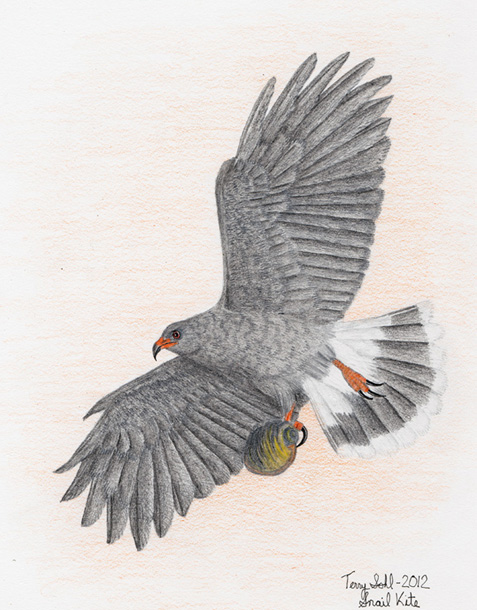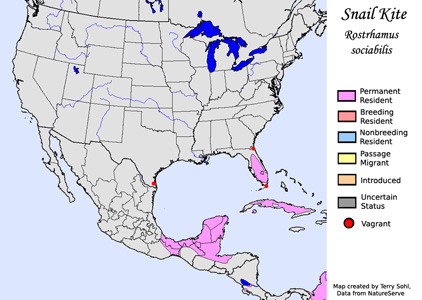| Length: 17 inches | Wingspan: 42 inches | Seasonality: Non-resident in South Dakota |
| ID Keys: Large, deeply-hooked bill, males gray overall, females browner with coarse barring underneath. | ||
 Hook-billed
Kites are a distinctive resident of Florida, although their range includes
much of Mexico, Central America, South America, and the Caribbean. The
obvious physical feature is the strongly hooked bill, an adaptation that
allows the Snail Kite to extract snails (their main prey) from their shells.
In the U.S., they are considered endangered, as they are highly susceptible
to habitat loss and resultant elimination of their main prey (apple snails).
Disruption of water flow to the Everglades and other parts of Florida have
undoubtedly resulted in a decline in the species over historical levels.
Hook-billed
Kites are a distinctive resident of Florida, although their range includes
much of Mexico, Central America, South America, and the Caribbean. The
obvious physical feature is the strongly hooked bill, an adaptation that
allows the Snail Kite to extract snails (their main prey) from their shells.
In the U.S., they are considered endangered, as they are highly susceptible
to habitat loss and resultant elimination of their main prey (apple snails).
Disruption of water flow to the Everglades and other parts of Florida have
undoubtedly resulted in a decline in the species over historical levels.
Habitat: Hook-billed Kites prefer shallow, fresh-water marshes with a mix of open water, wetland vegetation, and scattered trees or shrubs.
Diet: Feeds almost exclusively on large snails. In the U.S. portion of their range in Florida, they feed on apple snails. May also occasionally eat small reptiles, mammals, or crustaceans.
Behavior: Hunting is done by gliding slowly through wetlands, flying down to snatch snails in flight when they are spotted.
Nesting: The male builds a nest of sticks and twigs in a bush or tree, typically over water. Both parents help to incubate the eggs. After hatching, both parents will tend to the young for the first several weeks, although one parent then usually departs, leaving the remaining parent to finish tending to the young.
Song: Usually silent, although they do have a harsh, long cackling call, as well as other harsh calls.
Migration: Considered a permanent resident throughout its range. They may make short-term movements in response to changes in water level and prey abundance.
Interactive eBird map: Click here to access an interactive eBird map of Snail Kite sightings
Similar Species: Hook-billed Kite
Conservation Status: Globally, the species is common and widespread, with a broad geographic range and relatively healthy populations in most of Latin America. However, the species is listed as endangered in the United States.
Further Information: 1) Cornell's All About Birds - Snail Kite
2) National Park Service - Snail Kite
3) U.S. Fish and Wildlife Species Profile - Snail Kite
Image Information: Colored pencil drawing by Terry Sohl
| Click below for a higher-resolution map |
 |
| South Dakota Status: Non-resident in South Dakota |
Additional Swallow-tailed Kite Images

